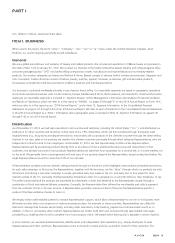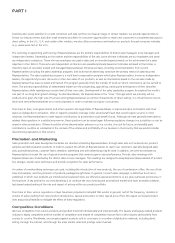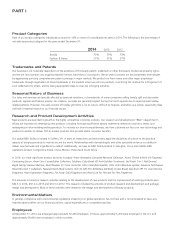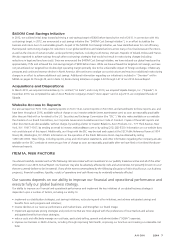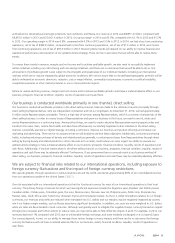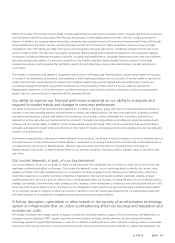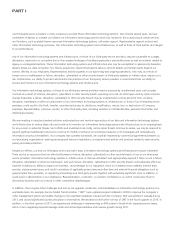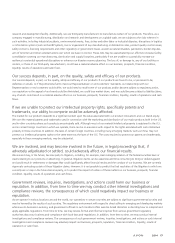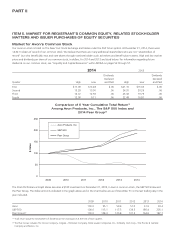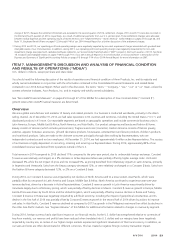Avon 2014 Annual Report Download - page 21
Download and view the complete annual report
Please find page 21 of the 2014 Avon annual report below. You can navigate through the pages in the report by either clicking on the pages listed below, or by using the keyword search tool below to find specific information within the annual report.Within the broader CPG industry, we principally compete against large and well-known cosmetics (color), fragrance and skincare companies
that manufacture and sell broad product lines through various types of retail establishments and other channels, including through the
Internet. In addition, we compete against many other companies that manufacture and sell more narrow beauty product lines sold through
retail establishments and other channels, including through the Internet. This industry is highly competitive, and some of our principal
competitors in the CPG industry are larger than we are and have greater resources than we do. Competitive activities on their part could
cause our sales to suffer. We also have many highly competitive global branded and private label competitors in the accessories, apparel,
housewares, and gift and decorative products industries, including retail establishments, principally department stores, mass merchandisers,
gift shops and specialty retailers. Our principal competition in the highly competitive fashion jewelry industry consists of a few large
companies and many small companies that sell fashion jewelry through department stores, mass merchandisers, specialty retailers and
e-commerce.
The number of competitors and degree of competition that we face in the beauty and related products industry varies widely from country
to country. If our advertising, promotional, merchandising or other marketing strategies are not successful, if we are unable to improve our
product mix and offer new products that represent technological breakthroughs and are aligned with local preferences, if we do not
successfully manage the timing of new product introductions or the profitability of these efforts, if we are unable to improve the
Representative experience, or if for other reasons our Representatives or end customers perceive competitors’ products as having greater
appeal, then our sales and results of operations will be adversely affected.
Our ability to improve our financial performance depends on our ability to anticipate and
respond to market trends and changes in consumer preferences.
Our ability to improve our financial performance depends on our ability to anticipate, gauge and react in a timely and effective manner to
changes in consumer spending patterns and preferences for beauty and related products. We must continually work to develop, produce
and market new products, maintain and enhance the recognition of our brands, achieve a favorable mix of products, and refine our
approach as to how and where we market and sell our products. Consumer spending patterns and preferences cannot be predicted with
certainty and can change rapidly. In addition, certain market trends may be short-lived. There can be no assurance that we will be able to
anticipate and respond to trends timely and effectively in the market for beauty and related products and changing consumer demands and
improve our financial results.
Furthermore, material shifts or decreases in market demand for our products, including as a result of changes in consumer spending patterns
and preferences or incorrect forecasting of market demand, could result in us carrying inventory that cannot be sold at anticipated prices or
increased product returns by our Representatives. Failure to maintain proper inventory levels or increased product returns by our
Representatives could result in a material adverse effect on our business, prospects, financial condition, liquidity, results of operations and
cash flows.
Our success depends, in part, on our key personnel.
Our success depends, in part, on our ability to retain our key personnel. The unexpected loss of or failure to retain one or more of our key
employees could adversely affect our business. Our success also depends, in part, on our continuing ability to identify, hire, attract, train,
develop and retain other highly qualified personnel. Competition for these employees can be intense and our ability to hire, attract and
retain them depends on our ability to provide competitive compensation. We may not be able to attract, assimilate, develop or retain
qualified personnel in the future, and our failure to do so could adversely affect our business, including the execution of our global business
strategy. For example, there have been many changes to the Company’s senior management, including a new chief executive officer in 2012
and a new chief financial officer in 2015. Any failure by our management team to perform as expected may have a material adverse effect
on our business, prospects, financial condition and results of operations. This risk may be exacerbated by the uncertainties associated with
the implementation of our stabilization strategies and restructuring and cost-savings initiatives.
A failure, disruption, cyberattack or other breach in the security of an information technology
system or infrastructure that we utilize could adversely affect our business and reputation and
increase our costs.
We employ information technology systems to support our business, including systems to support financial reporting, web-based tools, an
enterprise resource planning (“ERP”) system, and internal communication and data transfer networks. We also employ information
technology systems to support Representatives in many of our markets, including electronic order collection, invoicing systems, social media
tools and on-line training. We have e-commerce and Internet sites, including business-to-business websites to support Representatives. We
A V O N 2014 13


